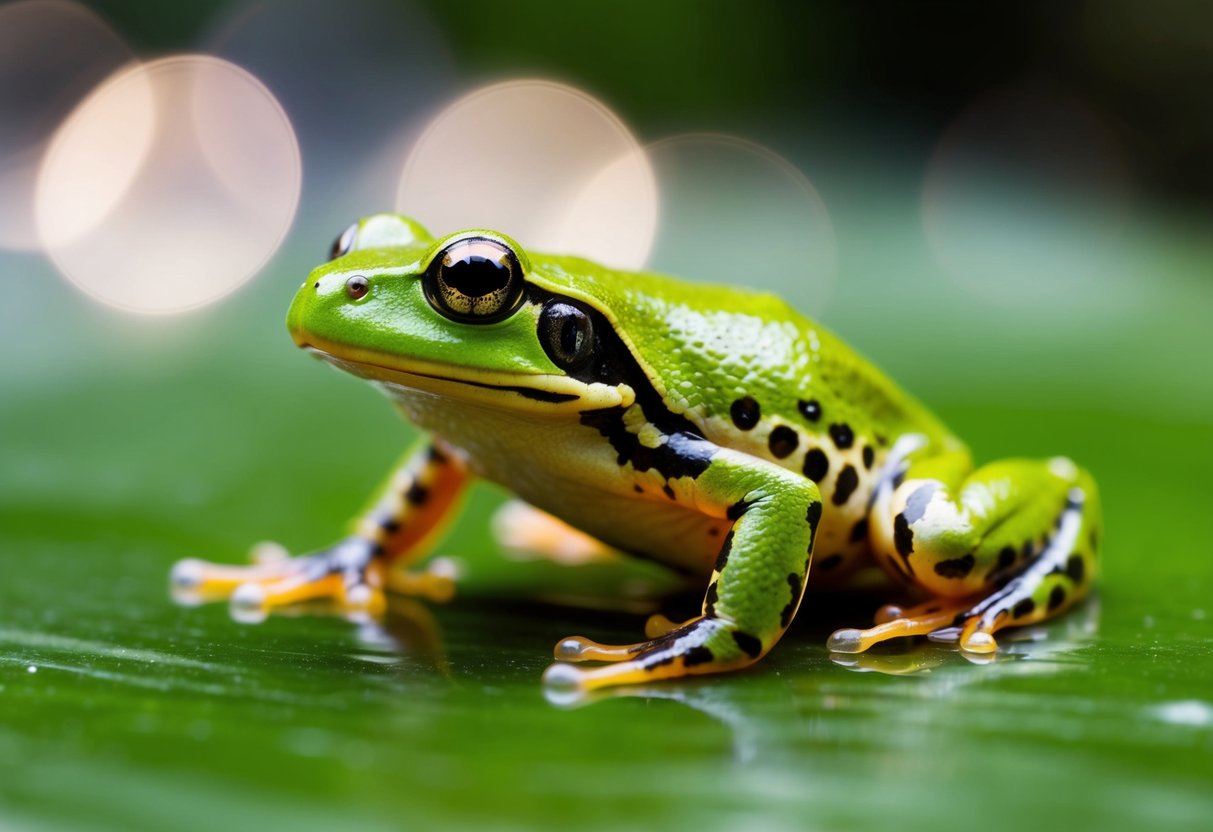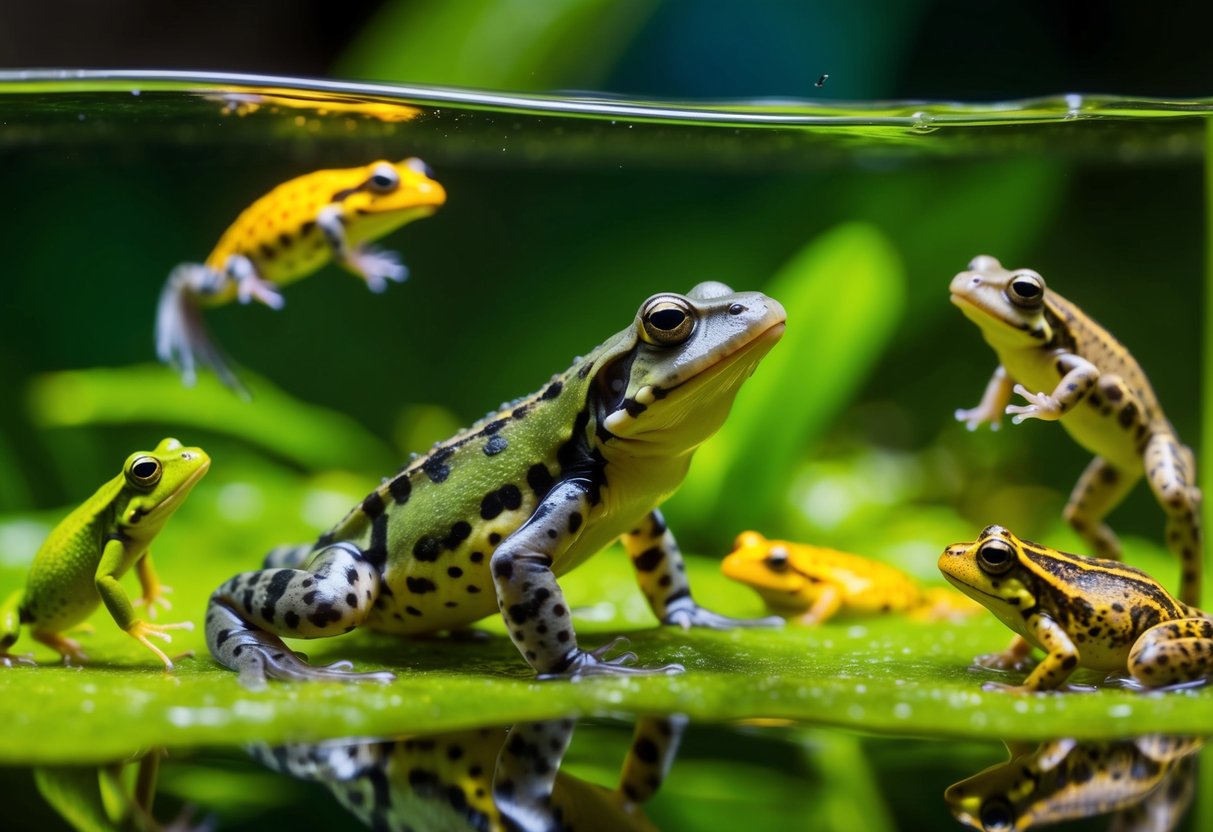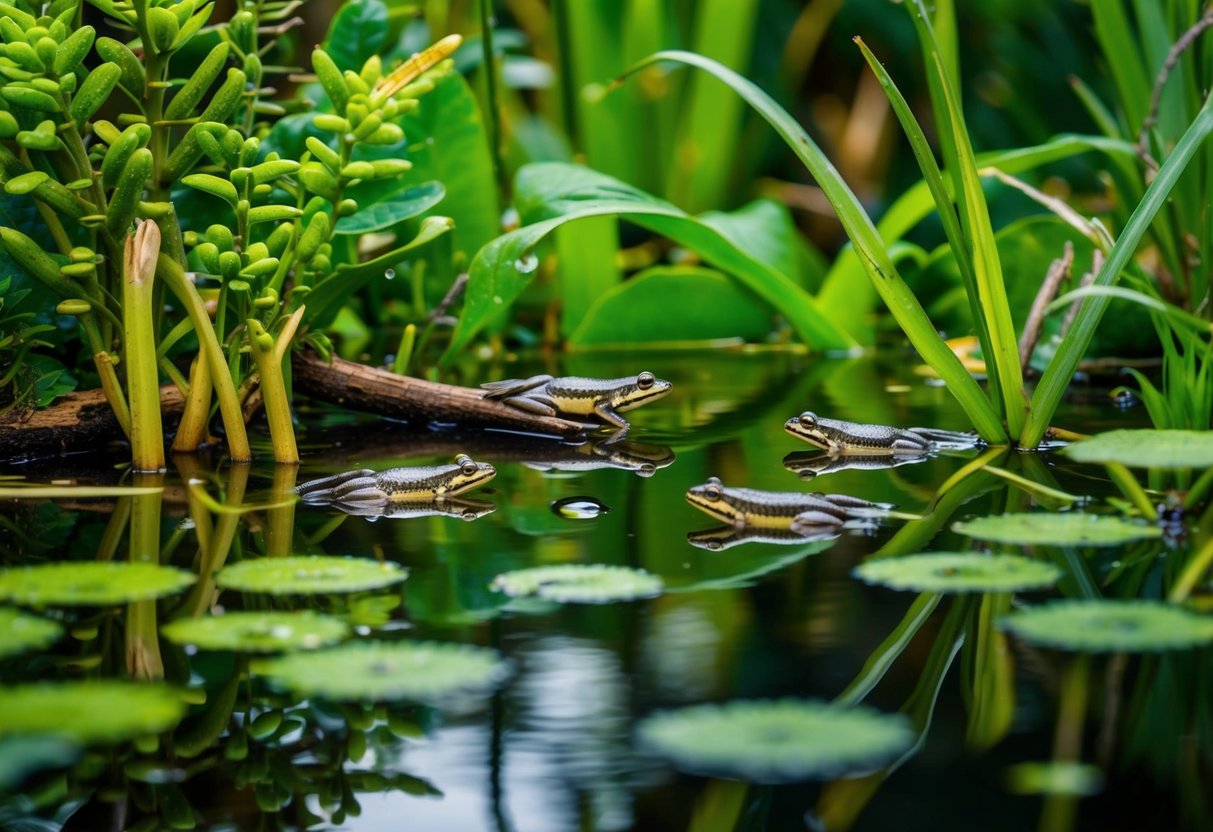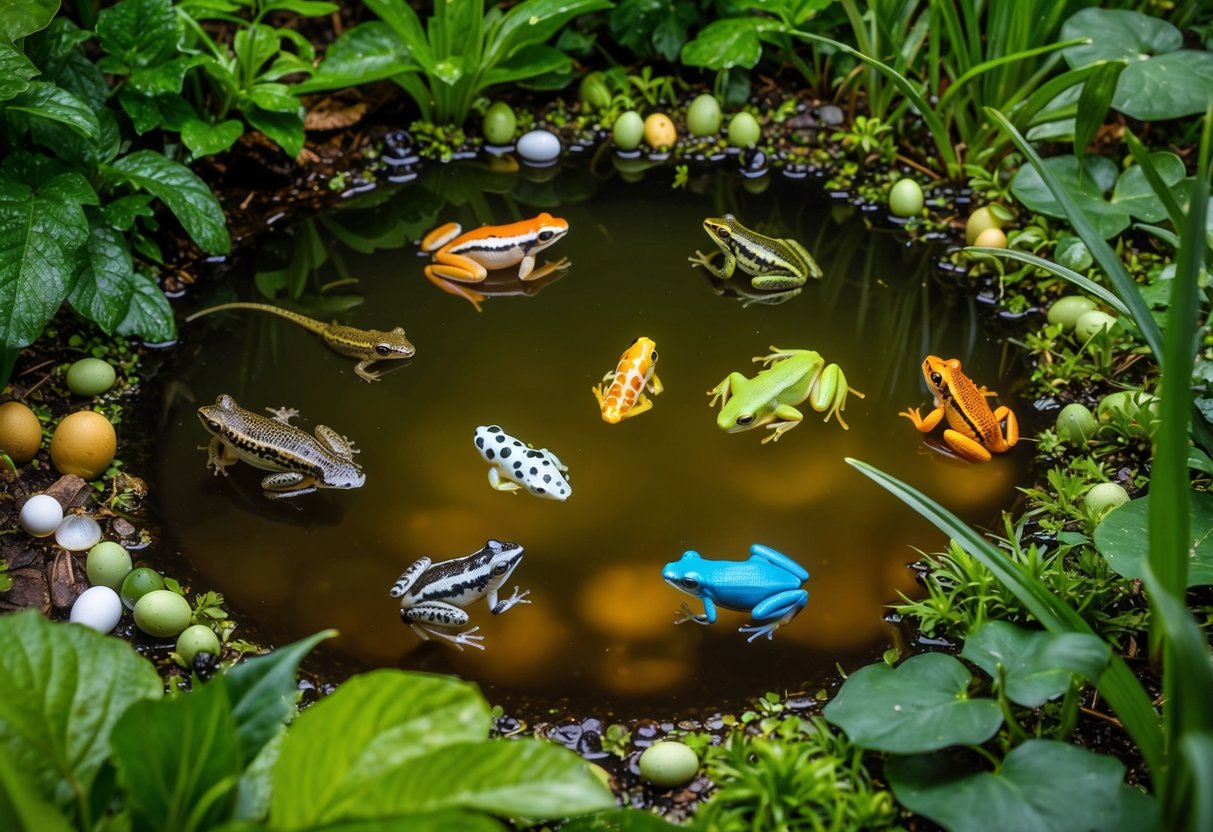Understanding Amphibian Developmental Stages: From Egg to Adult
Amphibians are unique creatures that undergo amazing changes as they grow. They start life in water and end up on land. This process is called metamorphosis.

Frogs, toads, and salamanders all go through similar stages as they develop. The life cycle of amphibians includes egg, larva, and adult stages, with major physical changes occurring during metamorphosis.
Amphibian eggs are usually laid in water. When they hatch, the young look very different from their parents.
Tadpoles have gills and tails for swimming. As they grow, they slowly change into their adult form with lungs and legs.
Key Takeaways
- Amphibians undergo a three-stage life cycle from egg to adult
- Tadpoles breathe with gills and transform to air-breathing adults
- Environmental factors can affect amphibian development and survival
Amphibian Classification
Amphibians form a diverse class of vertebrates with unique characteristics. They are grouped into distinct orders based on shared traits and evolutionary history.
Taxonomy Overview
Amphibians belong to the class Amphibia. This class is divided into three main orders:
- Anura (frogs and toads)
- Urodela (salamanders and newts)
- Gymnophiona (caecilians)
Each order has specific features that set it apart from the others. Anura, the largest group, includes tailless amphibians with long hind legs for jumping. Urodela have tails and are often mistaken for lizards. Gymnophiona are legless and worm-like.
Defining Amphibians
Amphibians are cold-blooded animals that can live both on land and in water. They have moist, permeable skin without scales. This skin helps them breathe and absorb water.
Most amphibians go through metamorphosis. They start life in water with gills and develop lungs as adults. Some key traits of amphibians include:
- Soft, moist skin
- Lack of scales or fur
- Ability to live on land and in water
- Cold-blooded (ectothermic)
- Lay jelly-like eggs without shells
Diversity Within Amphibia
The Amphibia class shows great diversity in form and habitat. Frogs range from tiny poison dart frogs to large bullfrogs. Salamanders can be aquatic, terrestrial, or even cave-dwelling.
Some unique amphibians include:
- Axolotls: Salamanders that keep their larval features as adults
- Caecilians: Burrowing, legless amphibians
- Tree frogs: Adapted for life in the canopy with sticky toe pads
Amphibians can be found in various habitats, from rainforests to deserts. This diversity showcases their adaptability and evolutionary success.
Early Developmental Processes
Amphibians undergo several crucial stages as they develop from a single fertilized egg into a complex organism. These processes lay the foundation for the animal’s body plan and organ systems.
Fertilization
Amphibian fertilization typically occurs externally. The male releases sperm over eggs laid by the female in water. When sperm enters the egg, it triggers a series of changes.
The egg’s outer layer hardens to prevent more sperm from entering. Inside, the egg and sperm nuclei fuse, forming a zygote.
The zygote now contains genetic material from both parents.
Cleavage and Blastulation
After fertilization, the zygote begins to divide rapidly. This process is called cleavage. In amphibians, cleavage is holoblastic, meaning it affects the entire egg.
The first two divisions are vertical, cutting through the egg’s poles. The third division is horizontal, creating eight cells.
Divisions continue, forming a hollow ball of cells called a blastula. The fluid-filled cavity inside is the blastocoel.
The blastula’s top half has smaller cells that divide faster. The bottom half has larger, yolk-filled cells that divide slower.
Gastrulation
Gastrulation reorganizes the blastula into a three-layered structure. It starts when cells at the blastula’s edge begin to move inward.
These cells form the blastopore, an opening that will become the anus. As more cells move in, they create three germ layers:
- Ectoderm (outer layer)
- Mesoderm (middle layer)
- Endoderm (inner layer)
Each layer will develop into specific body parts. The ectoderm forms skin and nerves. The mesoderm becomes muscles and bones. The endoderm develops into internal organs.
Neurulation
Neurulation is the formation of the nervous system. It begins as the ectoderm thickens to form the neural plate.
The edges of the neural plate fold upward and inward. They meet and fuse, creating a hollow tube. This neural tube will become the brain and spinal cord.
As the neural tube forms, nearby cells organize into segments called somites. These will develop into the vertebrae and muscles.
The head region of the neural tube expands, forming early brain structures. The rest of the tube becomes the spinal cord.
Embryonic Development
Amphibian embryos undergo complex changes as they transform from a single cell to a fully formed organism. This process involves the creation of different body layers, the formation of organs, and the growth of limbs.
Embryo Morphogenesis
Amphibian embryos start as a single fertilized egg cell. This cell divides many times to form a ball of cells. The ball then forms a hollow sphere called a blastula. Next, cells move inward to create three layers: ectoderm, mesoderm, and endoderm.
These layers will become different parts of the body. The ectoderm forms skin and nerves. The mesoderm forms muscles and bones. The endoderm forms internal organs.
As development continues, the embryo takes on a more complex shape. It forms a head, tail, and body segments. This process is called gastrulation.
Organ Formation
After the basic body plan is set, organs start to form. The nervous system is one of the first to develop. It starts as a small groove on the embryo’s back. This groove closes to form the neural tube, which becomes the brain and spinal cord.
The heart also forms early. It starts as a simple tube and later develops into a multi-chambered organ. Other organs like the liver, lungs, and kidneys develop from the endoderm layer.
As organs form, they begin to function. For example, the heart starts beating and pumping blood through the embryo’s body.
Limb Development
Amphibian limbs start as small buds on the sides of the embryo. These buds grow longer and form joints. Fingers and toes develop at the ends of the limbs.
In frogs and toads, the back legs grow first. The front legs develop later, often hidden under the gills. In salamanders, all four limbs grow at about the same rate.
As limbs grow, bones and muscles form inside them. Blood vessels and nerves also develop to support the new limbs. By the time the amphibian hatches, its limbs are usually well-developed.
Larval Stage
The larval stage is a crucial period in amphibian development. During this time, young amphibians undergo significant changes in form and function as they prepare for life on land.
Larval Morphology
Amphibian larvae, often called tadpoles, have a distinct appearance. They have a fish-like body shape with a long tail for swimming. Their heads are large in proportion to their bodies.
Most tadpoles have external gills for breathing underwater. These gills appear as feathery structures on the sides of the head.
The mouth of a tadpole is small and adapted for feeding on algae and plants. It has a hard, beak-like structure for scraping food.
Tadpoles lack limbs initially. As they grow, tiny buds appear where the legs will develop. The back legs usually form first, followed by the front legs.
Physiological Adaptations
Amphibian larvae are adapted for aquatic life. Their skin is permeable, allowing them to absorb oxygen from the water.
The digestive system of tadpoles is long and coiled. This helps them process their plant-based diet efficiently.
Tadpoles have a lateral line system. This sensory organ helps them detect movement and vibrations in the water.
As larvae grow, they develop lungs alongside their gills. This prepares them for breathing air when they move to land.
Hormones play a big role in larval development. Thyroid hormones trigger many of the changes that occur during metamorphosis.
Behavioral Characteristics
Amphibian larvae are active swimmers. They use their tails to move quickly through the water.
Many tadpoles form schools. This behavior helps protect them from predators.
Feeding takes up much of a tadpole’s time. They graze constantly on algae and plants to fuel their rapid growth.
Some tadpoles show predator avoidance behaviors. They may hide in vegetation or stay in shallow water to avoid larger fish.
As they near metamorphosis, tadpoles begin to spend more time near the water’s surface. This helps them prepare for life on land.
Metamorphosis
Amphibian metamorphosis is a remarkable process that transforms aquatic larvae into terrestrial adults. This change involves complex hormonal control, distinct stages, and a climactic finale that reshapes the organism’s body and functions.
Hormonal Control of Metamorphosis
The thyroid hormone plays a key role in amphibian metamorphosis. It triggers and regulates the changes that occur during this process. As tadpoles grow, their thyroid gland produces more of this hormone.
Other hormones also take part. Corticosteroids work with thyroid hormone to speed up metamorphosis. Growth hormone helps with tissue growth and organ development.
Environmental factors can affect hormone production. These include temperature, food supply, and water quality. Good conditions lead to faster metamorphosis, while poor ones can delay it.
Stages of Metamorphosis
Metamorphosis happens in stages. It starts with the growth of hind limbs in tadpoles. This is followed by the appearance of front limbs.
Next, the tail begins to shrink. The tadpole’s body shape changes to look more frog-like. Its internal organs also change.
The gills start to disappear as lungs develop. The tadpole’s diet shifts from plant-based to carnivorous. Its digestive system adapts to this new diet. The eyes and mouth also change shape and position.
Metamorphic Climax
The final stage of metamorphosis is called the climax. This is when the most dramatic changes occur.
The tadpole stops eating as its body undergoes major restructuring. During this time, the tail is fully absorbed.
The front legs emerge completely. The skull reshapes and the jaw widens. The skin becomes thicker and less permeable.
The lungs take over breathing completely. The heart changes from two chambers to three. The nervous system also undergoes significant changes to adapt to life on land.
Post-Metamorphic Development

Amphibians undergo significant changes after metamorphosis. This phase involves growth, maturation, and eventual aging as they transition from juveniles to adults.
Juvenile Phase
After metamorphosis, young amphibians enter the juvenile phase. They look like miniature adults but lack reproductive capabilities.
During this time, they focus on growth and survival. Juveniles often have different diets and habitats than adults.
For example, young frogs may eat smaller insects while adults tackle larger prey. Many species develop camouflage patterns to avoid predators.
Some salamanders lose their gills and develop lungs for terrestrial life. This phase can last weeks to years, depending on the species and environmental conditions.
Sexual Maturity
Amphibians reach sexual maturity at different ages. Some frogs mature in months, while certain salamanders take years.
Physical changes occur as they become able to reproduce:
- Development of sex organs
- Changes in body size and shape
- Appearance of breeding colors or structures
Environmental factors like temperature and food availability can affect the timing of sexual maturity.
Some species, like axolotls, can reproduce while retaining juvenile features. Breeding behaviors also emerge, such as vocalizations in frogs or courtship dances in newts.
Longevity and Aging
Amphibian lifespans vary greatly between species. Small frogs may live only a few years, while some salamanders can survive decades.
Factors affecting longevity include:
- Predation pressure
- Disease resistance
- Environmental stressors
- Genetic factors
As amphibians age, they may experience:
- Reduced fertility
- Slower metabolism
- Weakened immune systems
- Changes in skin texture or coloration
Some species show little signs of aging, a trait called negligible senescence. This is more common in certain salamanders and caecilians.
Developmental environment during early life stages can impact longevity and aging processes in adult amphibians.
Ecological Considerations

Amphibians have unique ecological needs and roles that shape their development and survival. Their life cycles are closely tied to specific habitats, adaptive traits, and important ecosystem functions.
Habitats and Distributions
Amphibians live in diverse environments worldwide. Many species depend on both aquatic and terrestrial habitats during different life stages.
Frogs and salamanders often breed in ponds, streams, or temporary water bodies. Some tropical frogs lay eggs in treetop bromeliads.
Adult amphibians may inhabit forests, grasslands, or even deserts. Certain salamanders live entirely on land or underground.
Climate and geography limit amphibian ranges. Most species thrive in warm, humid areas like tropical rainforests. Others have adapted to extreme conditions such as hot deserts or cold mountain peaks.
Adaptations for Survival
Amphibians have evolved special traits to cope with environmental challenges. Their permeable skin allows them to breathe and absorb water, but makes them sensitive to pollutants.
Many species can change color for camouflage. Some frogs have bright warning colors to deter predators.
To survive dry periods, certain frogs burrow underground and enter a dormant state called estivation. Desert species often emerge only after rains to breed.
Some salamanders can regrow lost limbs or tails. This ability helps them recover from injuries and escape predators.
Amphibians’ low dispersal rates compared to other vertebrates make them vulnerable to habitat changes. This limited movement shapes their population structures.
Role in Ecosystems
Amphibians play vital roles in food webs and nutrient cycles. As both predators and prey, they help control insect populations and provide food for many animals.
Tadpoles often eat algae in ponds, helping maintain water quality. Adult frogs and salamanders consume large numbers of insects, including pest species.
Amphibians’ life cycles link aquatic and terrestrial ecosystems. They transfer energy and nutrients between water and land habitats.
Their sensitivity to environmental changes makes amphibians useful indicator species. Declining amphibian populations can signal broader ecosystem problems.
Many cultures value amphibians for medicine, food, or spiritual reasons. This highlights their importance beyond purely ecological roles.
Conservation and Threats

Amphibians face many dangers as they grow. Climate change, habitat loss, and disease put them at risk. Efforts to save amphibians must address these issues at all life stages.
Impact of Environmental Change
Climate change affects amphibian development in big ways. Warmer temps can speed up growth but also dry up ponds. This leaves eggs and tadpoles without water.
Pollution harms amphibians too. Chemicals in water can cause deformities or kill young frogs.
Disease is another major threat. A fungus called chytrid has wiped out many frog species. It attacks their skin and stops them from breathing right. Some frogs are more at risk during certain growth stages.
Habitat loss is a big problem as well. When forests or wetlands vanish, amphibians lose their homes. This makes it hard for them to finish growing up and find mates.
Conservation Strategies
To help amphibians, we need plans that work for all their life stages.
Protecting habitats is key. This means saving both water and land areas where frogs live.
Captive breeding programs can boost wild populations. These keep frogs safe as they grow up. Then they’re released into nature.
Fighting disease is crucial too. Scientists are working on cures for the chytrid fungus. They’re also trying to make frogs more resistant to it.
Cutting pollution helps a lot. Clean water means healthier tadpoles and adult frogs. Some places are making laws to reduce harmful chemicals in the environment.
Research and Methodologies
Scientists use various methods to study amphibian growth. New tools help them learn more about how these animals develop.
Studying Amphibian Development
Amphibian life cycles often involve major changes. Researchers watch eggs turn into tadpoles and then into adult frogs or salamanders.
They measure growth rates and note when key changes happen. This includes the growth of legs and the loss of gills in many species.
Scientists also look at how the environment affects development. They test things like:
- Water temperature
- Food availability
- Presence of predators
These factors can speed up or slow down growth. They may even change how the adult animal looks or acts.
Technological Advances in Research
New tech makes it easier to study amphibians. High-speed cameras capture fast movements that the human eye can’t see.
Genetic tools help track how genes turn on and off during growth. This shows which genes control different parts of development.
3D imaging lets scientists see inside eggs and tadpoles without harming them. They can watch organs form in real time.
Tracking devices help follow amphibians in the wild. This shows how lab results compare to what happens in nature.
Frequently Asked Questions
Amphibian development involves complex stages and processes unique to these animals. Environmental factors play a crucial role in shaping their growth and metamorphosis.
What are the distinct stages of frog embryonic development?
Frog embryonic development begins with fertilization and cleavage. The embryo then undergoes gastrulation and neurulation. After this, organ formation starts.
The final stage is hatching, where the tadpole emerges from the egg.
How does gastrulation in amphibians differ from other vertebrates?
Amphibian gastrulation involves the formation of a blastopore. This process starts at the vegetal pole, unlike in other vertebrates.
The cells move inward to form the three germ layers: ectoderm, mesoderm, and endoderm.
What role does the notochord play in amphibian embryogenesis?
The notochord is a rod-like structure that forms during early development. It provides support and helps guide the formation of the nervous system.
The notochord also releases signals that influence the development of surrounding tissues.
Can you outline the four stages of metamorphosis in amphibians?
The four stages of amphibian metamorphosis are:
- Premetamorphosis: growth of the larva
- Prometamorphosis: development of hind limbs
- Metamorphic climax: rapid changes in body structure
- Juvenile stage: resembles adult form but not sexually mature
At what point in the developmental process do amphibians typically undergo metamorphosis?
Amphibians typically start metamorphosis after a period of larval growth. This usually occurs weeks to months after hatching, depending on the species.
How do environmental factors influence the growth and development of amphibians?
Temperature affects the speed of amphibian development. Warmer temperatures generally lead to faster growth and earlier metamorphosis.
Food availability impacts growth rate and size at metamorphosis. Meanwhile, predator presence can alter development timing and morphology.
Water quality and pollution levels can significantly affect amphibian development and survival rates.
